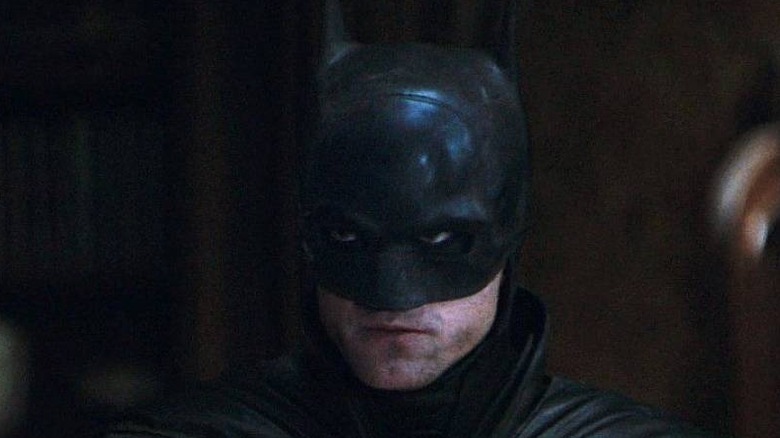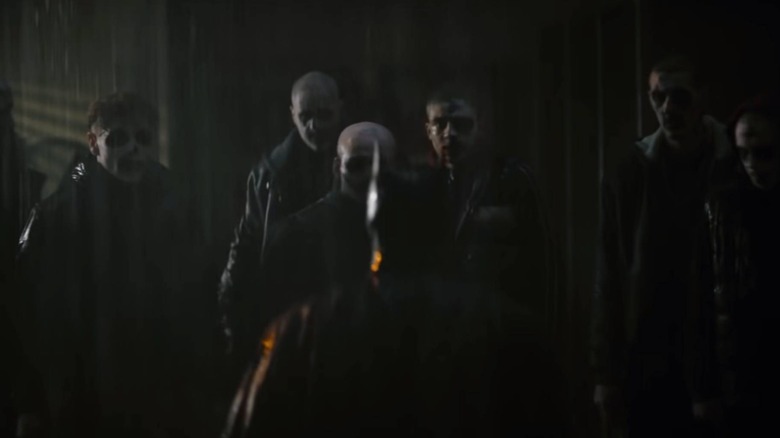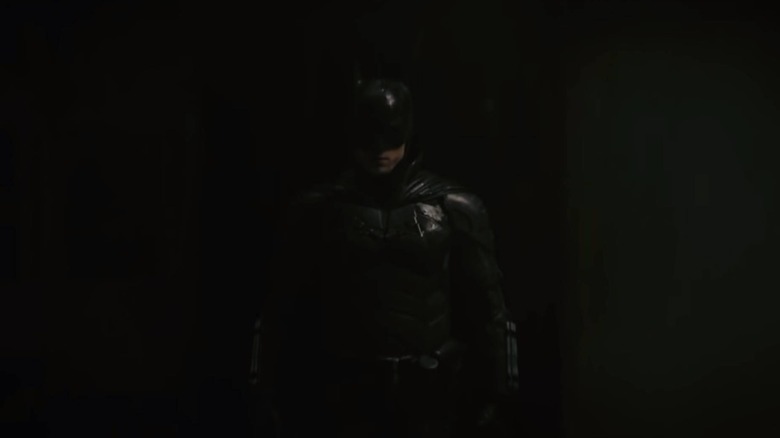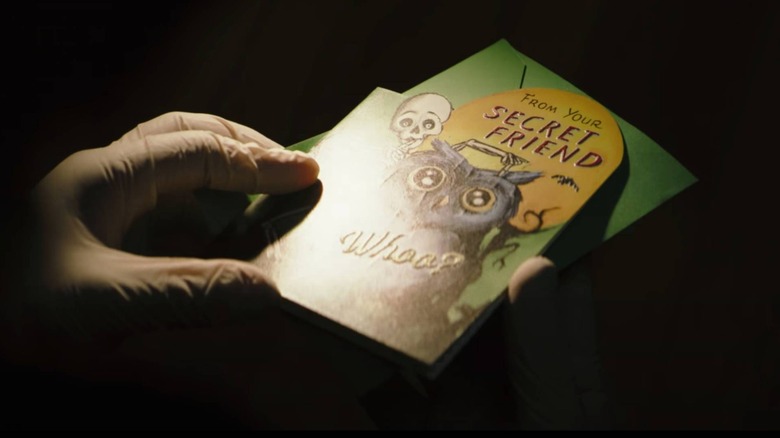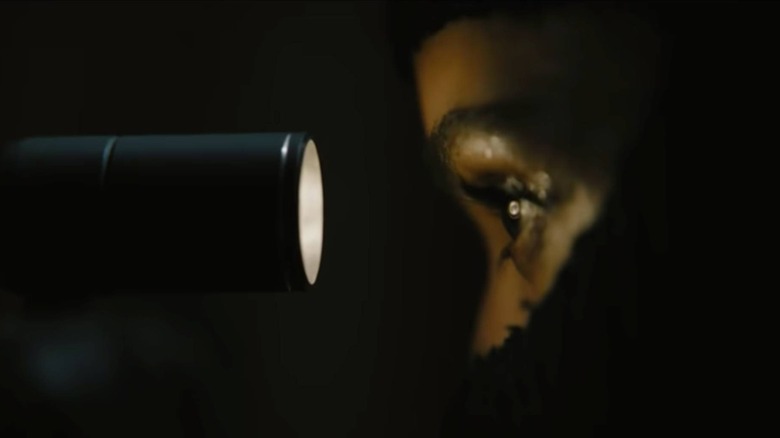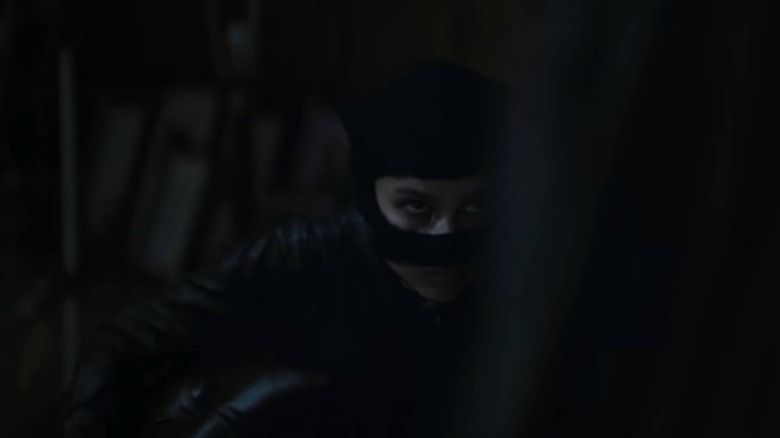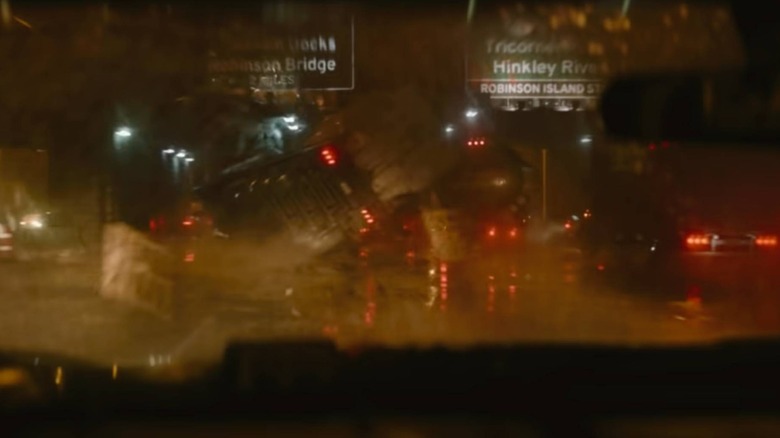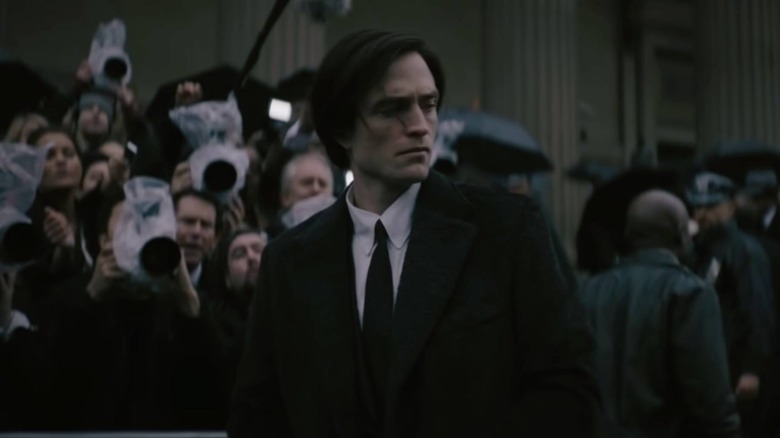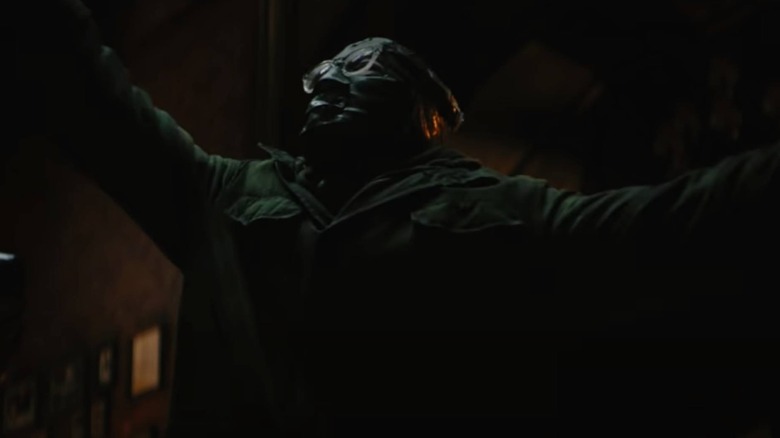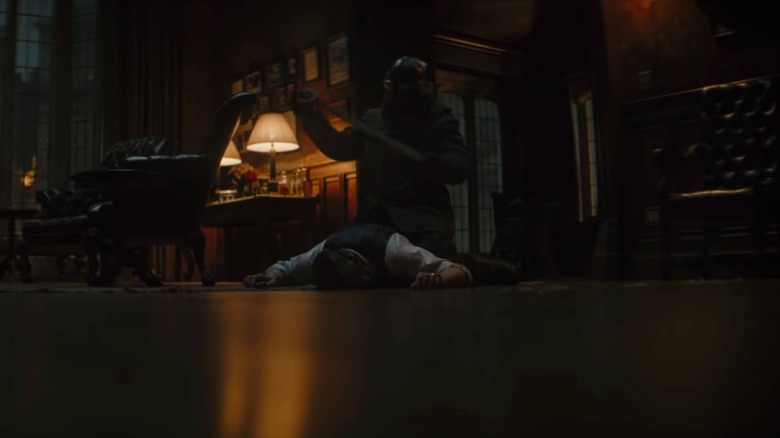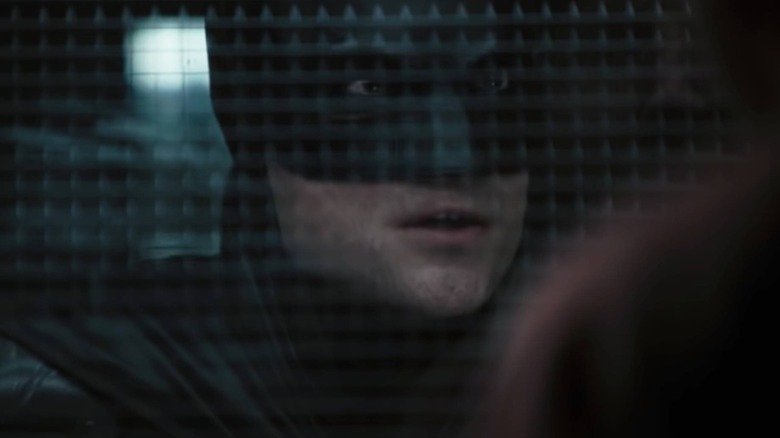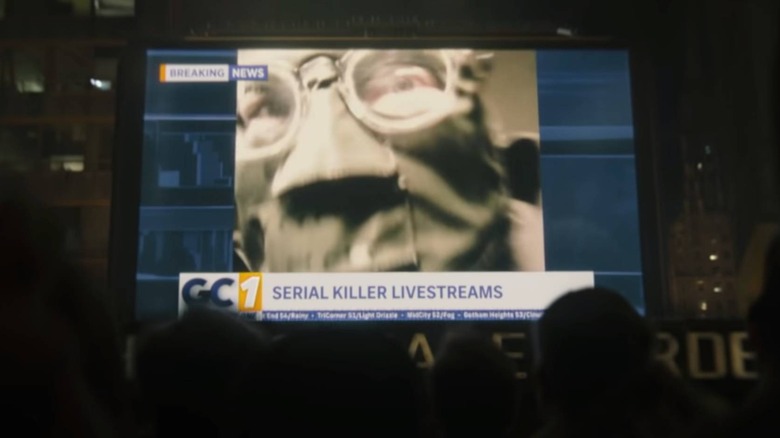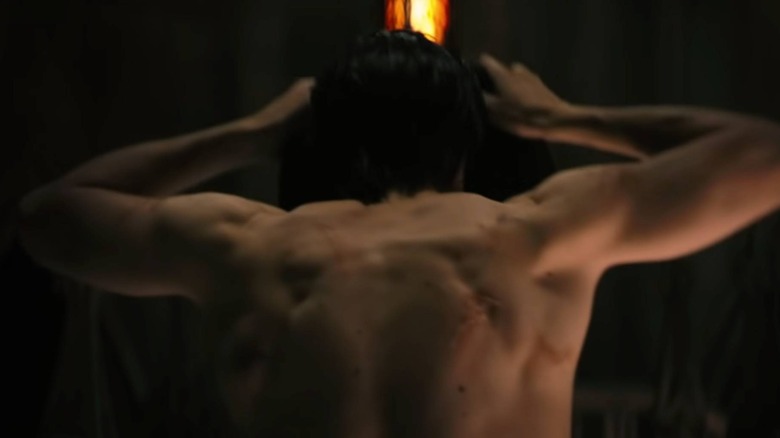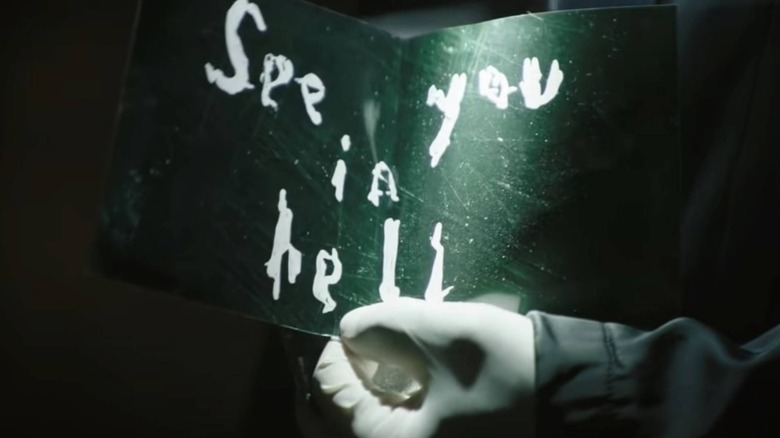Easter Eggs You Missed In The Batman
The following article contains spoilers for "The Batman."
"The Batman" is here, and for genuinely the first time in a live-action film, he's a detective. While other Batman movies have hinted at this side of the character, the newest adventure really leans into this aspect of his persona. He goes to crime scenes and studies evidence, even going so far as to record everything he sees via high-tech contact lenses so that he can analyze every detail at the Bat-Cave later.
However, Batman (Robert Pattinson) isn't the only one doing detective work throughout his latest film. Superhero moviegoers have become adept at studying every single frame of a new Marvel or DC project to find any hints or references to the comics. Filmmakers often litter these films with Easter eggs and small details that only the most eagle-eyed viewers could catch, making for a ton of fun in the process to track down every last aspect. See if you managed to catch every reference with this guide to the biggest Easter eggs found throughout "The Batman."
The gang at the beginning of the film could have several influences
The earliest action set-piece in "The Batman" comes fairly early on. Beforehand, we see a gang dressed in face makeup target a man, but before they can cause any real harm, Batman emerges from the shadows, ready to lay down the hurt.
The gang members never provide a name for themselves, and it's possible they only wore the face makeup because it was Halloween, but it's hard not to see a few influences on the aesthetic. First and foremost, there's the mutant gang that Batman fights in Frank Miller's "The Dark Knight Returns." They also boasted pasty-white skin, reminiscent of the gang. Plus, there's the Jokerz gang from "Batman Beyond," who dressed up as their favorite supervillain. Thanks to a brief cameo toward the end of the movie, we know Joker exists in this universe, so could he already have some minions at his disposal?
It's also worth mentioning the DC-related appearance in the gang fight scene. The young kid who's trying to become a member of the gang who refuses to hit either the man or Bruce Wayne is played by Lycurgo, who plays Tim Drake on "Titans."
I am vengeance
While on the subject of the opening fight, those thugs apparently didn't know who they were messing with. Right as Batman arrives on the scene, he lays down some hurt upon being asked who he is. After laying down the hurt, Batman responds in a way only Batman can: "I'm vengeance."
It's a cool line, and it also comes straight from "Batman: The Animated Series" in the 1990s. While one might assume the line would come from the pages of a comic book, the first time he actually uttered the phrase came in the episode, "Nothing to Fear," where Batman first runs into Scarecrow. At the end of the storyline, Batman's able to overcome his fears, and in the process, he lays down the pep talk to end all pep talks with, "I am vengeance! I am the night! I am Batman!"
Robert Pattinson's Batman may stop at the first third, but it's chilling nonetheless.
Riddler's cards hint at Batman's rogues gallery
Riddler (Paul Dano) takes after the Zodiac killer in more ways than one in "The Batman." Not only does he don a terrifying mask he wears when he targets his victims, but he also leaves behind puzzles and cyphers for the detectives to solve. Specifically, he leaves behind greeting cards for Batman himself, which contain clues that help reveal what it is he's actually looking for in all of this.
However, fans will want to pay attention to the outside of those cards. They may not mean much to the characters in the film, but fans should recognize that each card contains a reference to a different Batman adversary. For instance, the first card features an owl. It may come across as a spooky Halloween card initially, but fans should recognize the correlation to the Court of Owls from the comics.
That's not the only reference hidden in the cards. The second one has a Hugo Strange-like mad scientist. The third features a beautiful woman who looks an awful lot like Poison Ivy. The fourth has a set of eyes reminiscent of the Cheshire Cat, hinting toward Mad Hatter. And the fifth card includes a boy with a puppet, in an obvious reference to Scarface.
Each card references a different Caped Crusader villain, and honestly, any of them would make for a terrifying foe for "The Batman 2."
Martha's connection to the Arkhams
"The Batman" differs from previous Batman films by not necessarily depicting the murder of Thomas and Martha Wayne. Instead, their deaths are merely alluded to, and end up playing a significant role in the cover-up Riddler wants to expose. During one sequence featuring heavy exposition, we learn the truth behind the two most prominent families to ever grace Gotham — the Waynes and the Arkhams. We learn that during Thomas Wayne's run for mayor, a reporter threatened to expose Martha's time being institutionalized in Arkham Asylum.
Martha hasn't been related to the Arkhams in any previous movies, so this is clearly a reference to the Earth One storyline where her last name is Arkham before marrying Thomas Wayne. It makes the murder of the two philanthropists all the more devastating for the city, seeing how their union was a merging of two families that gave the city so much. And that's not the only familial connection the movie makes ...
Catwoman's true father
Even casual moviegoers know who Batman's parents are, but Selina Kyle's (Zoë Kravitz) lineage is more up in the air. While it's gone through some changes over the years, "The Batman" decides to borrow elements from "The Long Halloween" and "Dark Victory," making Catwoman's true father Carmine Falcone (John Turturro). The film establishes that her mother, Maria Kyle, died a long time ago, and she wants to get close enough to Falcone to kill him for what she did to her mom.
In the comics, the relationship between Selina and Carmine is far more circumstantial. While she has a strong hunch that Carmine is her father — as explored in 2004 miniseries "Catwoman: When in Rome" — she doesn't receive any definitive proof. She's far more sure of herself in the movie. In the film, he doesn't even know she's his daughter until she tells him.
Catwoman reenacts an iconic comic book scene
Prior to the release of "The Batman," a box set collection came out gathering Dark Knight stories that influenced the latest feature film. Among them was "Batman: Year One," even though director Matt Reeves was adamant that the movie wouldn't be an origin story like we've seen in the past. Still, as one of the most definitive Batman stories, it's understandable that the book would influence the first chapter of a new Batman story. And you can see that in how the movie recreates one of the most significant scenes in that storyline.
In "Year One," Catwoman scratches a side of Carmine's face, resulting in claw scars for the remainder of the comic book arc. A similar scene occurs in "The Batman" when Catwoman and Carmine get into a fight. She's out for revenge for what he did to her mother, and in the scuffle, she claws at his face with her extra long nails. It results in marks across his face, similar to what we've seen in "Year One." He sports that look throughout the rest of his time in "The Batman" until he's fatally shot by Riddler. It's not the only comic book recreation in the film, but it's arguably the one that's most likely to have moviegoers pointing at the screen to recognize it.
A shoutout on the bridge
There's a lot happening during the iconic car chase between Batman and Penguin. With so much going on, you'd be forgiven if you missed a quick shoutout to one of the most influential parties of the Dark Knight mythos.
At one point during the chase, you can see a street sign directing traffic to go somewhere called "Robinson Bridge." This is more than likely a reference to Jerry Robinson. He was a primary ghost artist for Batman comics throughout the 1940s, working closely with both Bob Kane and Bill Finger to develop many of the central tenets that went on to define the character. He's most often credited with helping to create Robin the Boy Wonder (via Portland Press Herald). He also claimed to have created Joker, but Bob Kane would repeatedly dispute that.
Regardless of who created what, Jerry Robinson was central to defining the character with many of his contributions still cropping up in Batman adaptations to this day. It's nice to see a shoutout to the legendary artist in the latest iteration of the character.
Numerous nods to the 1966 series
Director Matt Reeves is apparently quite a big fan of the original 1966 "Batman" TV series. Prior to shooting "The Batman," he attended a "Batman" '66 exhibit, complete with a plethora of photos he uploaded to Twitter (via Screen Rant).
That influence seems to have carried over into "The Batman." For starters, you can find a bust of William Shakespeare in the background of Bruce Wayne's office. This is an allusion to 1966's "Batman" where Bruce Wayne, played by Adam West, would access the Batcave through a secret switch that he kept hidden within a bust of, you guessed it, William Shakespeare.
But that's not all. Later in the movie, Batman runs down the side of a building using a decel cable. This is another allusion to 1966's "Batman" as the Caped Crusader and the Boy Wonder Robin, played by Burt Ward, would often scale the side of buildings using a cable. And that's not even mentioning the fact that Riddler, Catwoman, and Penguin were featured prominently in the series as well as the movie that came out based on the show.
Riddler reveals his real name
Naturally, "Riddler" isn't the character's actual name. But most audience goers probably know his true identity as Edward Nygma. This has been his real name in the likes of "Batman Forever" and "Gotham." In true comic book fashion, the name shortens to "E. Nygma," or "enigma," which is appropriate for a man who loves puzzles and riddles. However, for some, the name might be a bit too cartoony for more serious fare, which is why the character has the name of "Edward Nashton" in "The Batman."
In the comic books post-"Crisis on Infinite Earths," it's established that Riddler's birth name is Edward Nashton. It allows the character to have a more grounded persona, but in true supervillain fashion, he changes his last name to "Nygma" to better fit his new persona.
Director and co-writer Matt Reeves has yet to publicly state why he opted to go for the "Nashton" name, but after watching "The Batman," it's easy to see why. The film takes on the tone of a dark noir film, so having the primary villain have a pun for a real name probably wouldn't work for the more down-to-earth feel of the movie. Still, Reeves managed to squeeze in a nod to Riddler's alternate names throughout his comic book continuity. When Riddler's apprehended at the diner, the police find two alternate I.D.'s on his person, hinting at the various names he's held over the years.
Riddler flooding Gotham is a reference to Zero Year
Another major moment pulled straight from the comics occurs during the beginning of the film's final act. As Batman confronts Riddler, who's locked away in Arkham Asylum, he reveals that the machinations of his grand final plan are already well underway. It's similar to how Ozymandias in "Watchmen" already set his plan in motion before there was anything the heroes could do to stop it. In this instance, "The Batman" finale takes place in a Gotham that's been flooded by water after various flood walls break apart in an explosion set forth by Riddler and his henchmen.
The plan should be familiar to anyone who read the "Zero Year" comic book arc. In that storyline, Riddler manages to do the same thing, flooding Gotham and turning it into an apocalyptic wasteland. It's up to Batman to restore order to the city, and Riddler becomes the first major foe the vigilante goes up against now that he's taken control of the city.
The movie differs from what happens in the comics a bit. Notably, Riddler remains locked in Arkham by the film's ending, so he doesn't become the makeshift ruler of Gotham. It's also unclear how soon after the ending of "The Batman" the sequel would take place. Will everything be back to normal in the city, or will the sequel explore the ramifications of a martial law Gotham further? Either way, it certainly makes for an impactful ending with Batman suffering even though he technically "wins" over Riddler.
Does Batman have Venom?
An intriguing development occurs during the big climactic final battle between Batman and Catwoman versus Riddler's henchmen. At a certain point, Batman becomes too overwhelmed. He's weakened from taking on so many enemies at once, and he just doesn't have the stamina to take down more goons as they turn their attention to Selina Kyle. To help him get back on his feet, Batman takes out a vial containing a green substance. He injects himself with the material, and he suddenly receives the strength to get back on his feet and pummel the final Riddler henchman into submission.
It might take some fans by surprise, especially seeing how the vial wasn't set up earlier in the film. However, fans of the comics and/or "Batman vs. Robin" may recognize the substance as having similar properties to Venom, which is what Bane uses to give himself super-strength. After all, it does appear to give Batman a boost in energy and strength. It also vastly increases his hostility, as he goes way over the limit beating up the thug to the point where the Gotham P.D. have to pull him off. That level of savagery could also be attributed to what we've seen out of Venom in the past.
Could this mean that Bane could appear in a subsequent "Batman" movie? Similar to Riddler's cards, it could just be a fun Easter egg to hint at a larger world out there. After all, the universe of "The Batman" will be further explored in HBO Max TV series centered on Gotham P.D. and Penguin, so there are plenty of avenues for Bane to make his way into this franchise.
It's worth pointing out there's no confirmation the green vial contained specifically Venom. It could've been a completely separate adrenaline shot. But the similarities are hard to ignore.
Who could possibly be Riddler's next-door neighbor?
By the end of the film, Batman has stopped the Riddler's reign of terror. Some lives may have been lost, and the city remains flooded. But hopefully, Gotham can come together to rebuild once more, especially seeing how Riddler is safely behind bars at Arkham Asylum. When we check in with him again, he looks pretty despondent, since his plan got away from him. However, there's someone in a cell next to his who manages to put a smile on that face once again, and while they're never mentioned by name, we can make a pretty educated guess.
Riddler's neighbor makes a reference to how one day a person can feel like they're on top of the world, but the next day, the world sees them as a clown. Additionally, once he ends his diatribe, he begins laughing maniacally in such a manner that gets Riddler chuckling, too. It's easy to put two and two together and surmise that this individual, played by Barry Keoghan, will be the latest iteration of Joker.
In the credits, this person is listed as "Unseen Arkham Prisoner," so it does give those working behind the scenes some leeway as to whether they want to pursue a Joker storyline for a future installment of "The Batman" series. After all, when asked about who he'd like to include in the sequel, Matt Reeves responded with Mr. Freeze, not Joker (via Collider). Still, it's exciting to think that Joker is out there somewhere, just waiting to unleash his signature brand of chaos on unsuspecting Gothamites.
Blüdhaven gets a shoutout
For years, Warner Bros. tried to get a shared cinematic universe up-and-running with the DC Extended Universe. This established that films like "Man of Steel," "Wonder Woman," and "Aquaman" all existed within the same timeline, similar to what Marvel had accomplished with the MCU. Over the years, the franchise has been met with mixed responses, so DC has branched off into other separate entities since the beginnings of the DCEU. "The Batman" falls into that category as it exists in its own separate timeline, completely detached from what Ben Affleck had done during his tenure as the Dark Knight.
As such, there aren't too many references to other DC properties outside of the Batman mythos. You won't find anyone referencing Metropolis or Superman in this movie; however, it does manage to accomplish a bit of world-building that could easily pay off down the line. Toward the end of the flick, Catwoman mentions how she's going to get out of Gotham for a while and perhaps head up to Blüdhaven.
The name should sound familiar to anyone who's read the Batman comics or checked out "Arrow" on The CW. The fictional city has come up frequently in DC Comics over the years as a nearby locale to Gotham. In fact, when Nightwing decides to venture out as his own hero, he sets up his base of operations in Blüdhaven to get away from Batman.
What does this mean for the future of "The Batman?" It might mean nothing and serve as solely a way to get Catwoman out of the picture to make room for other villains/anti-heroes in "The Batman 2." But it's good to know that if Dick Grayson ever enters the fold, Blüdhaven is there, awaiting its protector.
You can actually visit the website teased in the post-credits scene
It's become commonplace for superhero movies to contain mid- or post-credits scenes. Fans have come to anticipate a fun joke or a teaser of what's to come in the sequel, and no doubt plenty of theatergoers will wait around until the credits have finished to see if "The Batman" has anything worth sticking around for.
There's no teaser scene to speak of at the very end of "The Batman." There's no hint of Mr. Freeze entering the picture or anything like that. However, it does contain a bit of coding. This is then followed up with a blink-and-you'll-miss-it tag of a web address that reads, "www.rataalada.com." Viewers will remember this is the URL Batman and Gordon (Jeffrey Wright) had to visit about halfway through the movie when they realize Riddler gave them a web address.
As it turns out, you can actually visit this URL on your phone or computer when you get back home. It will take you to a website where you'll encounter some of Riddler's puzzles, attempting to answer them to reveal the truth. It appears the riddles are different each time you visit the site, but one of the trick questions you'll encounter is, "From birth to death. From boy to man. All things change, but this is one thing he will always be." And don't think you can get any hints on other websites. If you click away from the page, you're greeted with a message reading, "You scour the internet for the truth, but you still need to answer me."
Maybe you can try looking for hints on another device if you need some help.
